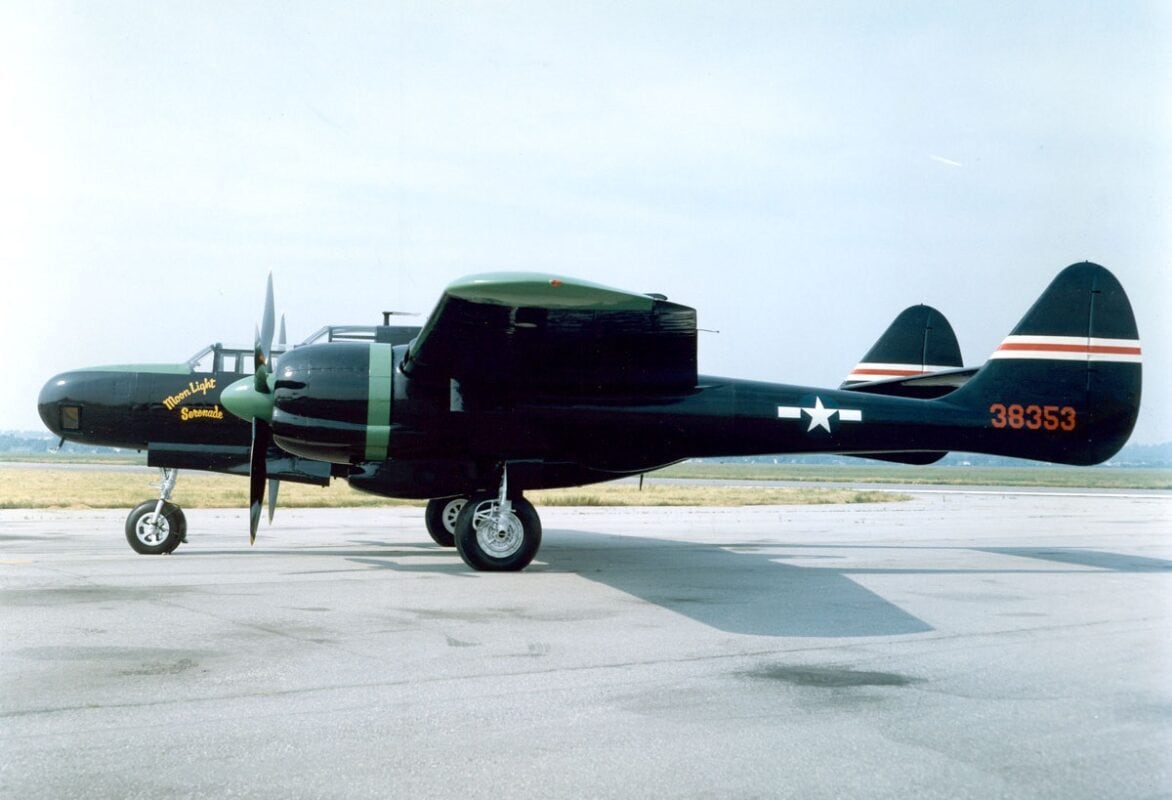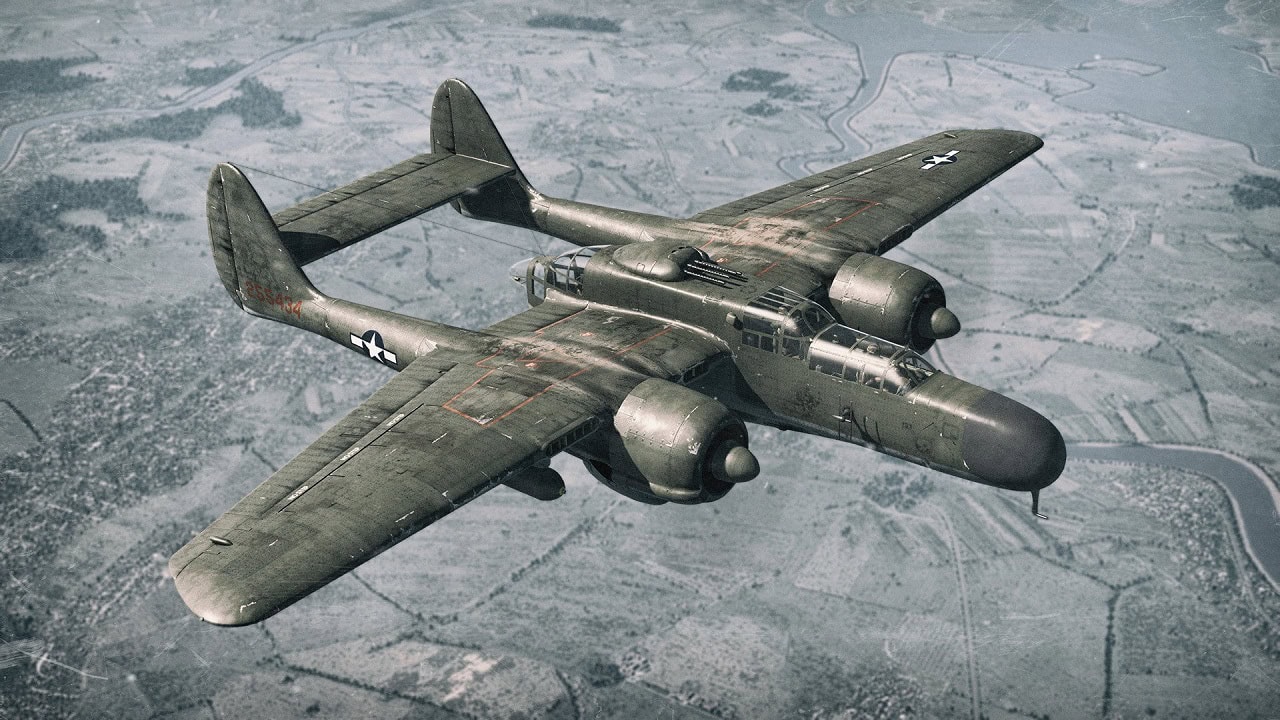Spiders, in spite of their frightful reputation propagated by nursery rhymes like “Little Miss Muffet” and popular movies like Arachnophobia, are, by and large, beneficial to humankind. They help control the insect pest population, after all. That said, there are some species of spider that can be deadly to humans, though actual deaths from their venomous bites are thankfully quite rare nowadays. Of the man-killing (and woman-killing, for the sake of equal opportunity) species, only one has become the namesake of a warplane: the WWII-era P-61 Black Widow, America’s first night fighter. (Heck, let’s face it, Brown Recluse just wouldn’t have the same ring to it as a military aviation moniker). Let’s take a closer look at how this Black Widow owned the night, i.e. how America’s aerial arachnid annihilated Axis aerial adversaries (ah, alliteration).
Your Not-So-Friendly (to the enemy, that is) Neighborhood Spiderplane
The Northrup P-61 Black Widow made her maiden flight on 26 May 1942, a mere three years after the manufacturing company’s founding by the late great John Knudsen “Jack” Northrup (1895 – 1981). The large, powerful, all-metal, twin-engine aircraft made aviation history not only as the first U.S. dedicated night fighter but also as the first aircraft designed to use radar. As noted by my 19FortyFive colleague Peter Suciu, “the design and development of the P-61’s SCR-720 search radar, which was placed at the front nose of the fighter, reportedly involved 172,000 man-hours of work.” (As a sidebar note, that right there was just one of many testaments to American industrial capacity during the Second World War.)
The fighter plane had a three-man crew: pilot, gunner, and radio operator. These terrific trios had some impressive firepower at their disposal, namely four Hispano M2 20mm cannons mounted in the lower fuselage, and four Browning M2 “Ma Deuce” .50 caliber machine guns mounted in the dorsal gun turret. The P-61’s two Pratt & Whitney R-2800-65 Double Wasp 18-Cylinder engines were rated at 2,250 hp and propelled (bad pun intended) the Black Widow through the skies at a max airspeed of 369mph (593.8kph) and a max range of 1,350 miles (2,172 kilometers).
Black Widow Blows ’em a-Way…
The warbird (yes, I’m mixing avian and arachnid metaphors here) didn’t actually go operational until 1944, meaning she was only able to garner one year of combat experience. But the Black Widow certainly made the most of that short time.
On 6 July 1944, the Black Widow lived up to her venomous namesake by garnering her first air-to-air kill, a Japanese Mitsubishi G4M “Betty” bomber downed over the Central Pacific. (Coincidentally, the “Betty” was the aircraft type that Imperial Japanese Navy Admiral Isoroku Yamamoto had been riding in when he was fatally shot down the year prior.) Meanwhile, over in the European Theater of Operations, P-61s racked up a respectable record by downing 18 of Nazi Germany’s V-1 “Buzz Bomb” terror weapons. All told, P-61 crews racked up a tally of 127 aerial victories; one P-61 crew in the Pacific Theater made ace, along with three of their European counterparts.
In addition to the aforementioned claims to fame as America’s first-night fighter and the first plane to be designed with radar, the Black Widow would make aviation history via one more significant distinction: Lady in the Dark, piloted by Captain Lee Kendall, scored the final two aerial kills of WWII. To quote Peter Suciu again, “One was on the last night of the war, while another was almost 24 hours after the hostilities had officially ended. Kendall was able to down two Japanese aircraft, likely planning kamikaze attacks, by pursuing those enemies and without firing shot caused both to crash!”
In Mr. Kendall’s own words, “I feel thankful now that I wasn’t the direct instrument in shooting him down.” He was finally awarded the Distinguished Flying Cross for his accomplishments in 1991, and passed away on 2 March 2018 at the age of 98.
Where Are They Now?
The Black Widow was officially retired in 1954. Out of a total 0f 706 P-61s built, only four survive today, none of which are airworthy. Unfortunately, one of them is in the hands of the ChiComs — apparently taken by Chairman Mao’s goons at the end of WWII — languishing in the Beijing Air and Space Museum at Beihang University. The other three are where they belong, in the good ol’ US of A: the Mid-Atlantic Air Museum in Reading, Pennsylvania; at the Steven F. Udvar-Hazy Center of the National Air and Space Museum in Chantilly, Virginia; and at the National Museum of the United States Air Force at Wright-Patterson AFB, Ohio.

DAYTON, Ohio — Northrop P-61C Black Widow at the National Museum of the United States Air Force. (U.S. Air Force photo)
Christian D. Orr is a former Air Force officer, Federal law enforcement officer, and private military contractor (with assignments worked in Iraq, the United Arab Emirates, Kosovo, Japan, Germany, and the Pentagon). Chris holds a B.A. in International Relations from the University of Southern California (USC) and an M.A. in Intelligence Studies (concentration in Terrorism Studies) from American Military University (AMU). He has also been published in The Daily Torch and The Journal of Intelligence and Cyber Security. Last but not least, he is a Companion of the Order of the Naval Order of the United States (NOUS).

